A Bibliometric Analysis of the Research Progress and Trends during 2002–2022 on the Carbon Stocks in Terrestrial Ecosystems
Abstract
:1. Introduction
2. Data Sources and Research Methods
3. Results and Discussion
3.1. Publication Trend Analysis
3.2. Research Hotspots and Trends
3.3. Research Areas and Current Status of Carbon Stocks in Terrestrial Ecosystems
3.3.1. Early Basic Clusters
3.3.2. Midterm Development Clusters
3.3.3. Recent Persistent Clusters
3.4. Country Cooperation Network Analysis
3.5. Marked Journals
3.6. Competitive Authors
4. Conclusions and Future Research Directions
- (1)
- Carbon stock research showed an expanding trend during 2002–2022. The research in various countries showed important research trends in different fields, the number of publications and citations rose, and the cooperation between countries showed a developing trend, especially for the United States and China, which exhibited the strongest cooperation, and the United Kingdom, which had the highest degree of centrality.
- (2)
- The most frequently occurring keyword phrase was “climate change”, and this gradually evolved into “interannual variability”, “temperature sensitivity”, “tree mortality”, “temperature sensitivity”, and “tree mortality”, indicating that quantifying the interannual variability in temperature and vegetation sensitivity and the adaptation to temperature under the influence of climate change were the main themes extended. Balancing the urbanization process and maximizing the carbon storage capacity in ecosystems have gradually become two of the more important themes.
- (3)
- Through a citation analysis, we categorized the clusters related to the carbon storage in terrestrial ecosystems into early basic, midterm development, and recent persistent clusters. Most of the research has focused on carbon sink and source assessment methods, carbon stock drivers, and the accurate monitoring and management of global carbon sinks. The research methods have gradually evolved from the early eddy correlation method, carbon balance modeling, and soil respiration monitoring to remote sensing technology and ecosystem modeling.
Author Contributions
Funding
Data Availability Statement
Acknowledgments
Conflicts of Interest
References
- Lashof, D.A.; Ahuja, D.R. Relative contributions of greenhouse gas emissions to global warming. Nature 1990, 344, 529–531. [Google Scholar] [CrossRef]
- McPherson, E.G.; Simpson, J.R. Carbon Dioxide Reduction through Urban Forestry: Guidelines for Professional and Volunteer Tree Planters; General Technical Reports, PSW-GTR-171; U.S. Department of Agriculture, Forest Service, Pacific Southwest Research Station: Albany, CA, USA, 1999; 237p. [Google Scholar] [CrossRef]
- Benitez, R.F.M.; Goncalves, J.; Laercio, A.; Miquelino, E.T.; Ribeiro, S.C.; Silva, S.R.; Oliveira, N.T.; Gaspar, R.O.; da Silva, L.F.; Vidal, E.; et al. Aboveground biomass allometric models for large trees in southwestern Amazonia. Trees For. People 2022, 9, 100317. [Google Scholar] [CrossRef]
- Ewing, P.M.; Tu, X.Y.; Runck, B.C.; Nord, A.C.; Snapp, S.S. Smallholder farms have and can store more carbon than previously estimated. Glob. Chang. Biol. 2023, 29, 1471–1483. [Google Scholar] [CrossRef]
- Di, M.G.; Luzzi, G.; Basile, A.; Sposato, A.; Bertini, G.; Neri, U.; Pennelli, B.; Napoli, R.; Nardi, P. Carbon concentrations and carbon storage capacity of three old-growth forests in the Sila National Park, Southern Italy. J. For. Res. 2023, 34, 233–242. [Google Scholar] [CrossRef]
- Cannell, M.G.R. Growing trees to sequester carbon in the UK: Answers to some common questions. Forestry 1999, 72, 237–247. [Google Scholar] [CrossRef]
- IPCC. Climate change 2021: The physical science basis. In Contribution of Working Group I to the 6th Assessment Report of the Intergovernmental Panel on Climate Change; Cambridge Press: Cambridge, UK, 2021. [Google Scholar]
- Fang, J. Ecological perspectives of carbon neutrality. Chin. J. Plant Ecol. 2021, 45, 1173–1176. [Google Scholar] [CrossRef]
- Wang, Y.L.; Wang, X.H.; Wang, K.; Chevallier, F.Z.; Lian, J.H.; He, Y.; Tian, H.Q.; Li, J.S.; Zhu, J.X.; Jeong, S.J.; et al. The size of the land carbon sink in China. Nature 2022, 603, 7–9. [Google Scholar] [CrossRef]
- Mallapaty, S. How China could be carbon neutral by mid-century. Nature 2020, 586, 482–483. [Google Scholar] [CrossRef]
- Chen, H.; Qi, S.Z.; Tan, X.J. Decomposition and prediction of China’s carbon emission intensity towards carbon neutrality: From perspectives of national, regional and sectoral level. Sci. Total Environ. 2022, 825, 153839. [Google Scholar] [CrossRef]
- Bonan, G.B. Forests and climate change: Forcings, feedbacks, and the climate benefits of forests. Science 2008, 320, 1444–1449. [Google Scholar] [CrossRef]
- Jha, S.K.; Negi, A.K.; Alatalo, J.M.; Prabhu, V.; Jha, M.B.; Kumar, H. Forest degradation index: A tool for forest vulnerability assessment in Indian Western Himalaya. Sustainability 2022, 14, 15655. [Google Scholar] [CrossRef]
- Ganatsas, P.; Tsakaldimi, M.; Karydopoulos, T.; Petaloudi, L.M.; Papaemmanouil, A.; Papadopoulos, S.; Gerochristou, S. Carbon pools in a 77 year-old oak forest under conversion from coppice to high forest. Sustainability 2022, 14, 13764. [Google Scholar] [CrossRef]
- Piao, S.L.; He, Y.; Wang, X.H.; Chen, F.H. Estimation of China’s terrestrial ecosystem carbon sink: Methods, progress and prospects. Sci. China Earth Sci. 2022, 65, 641–651. [Google Scholar] [CrossRef]
- Sun, W.L.; Son, Y.H.; He, B.S.; Liu, X.H. An individual tree-based model for estimating regional and temporal carbon storage of Abies chensiensis forest ecosystem in the Qinling Mountains, China. Ecol. Model. 2023, 479, 110305. [Google Scholar] [CrossRef]
- Enting, I.G.; Rayner, P.J.; Ciais, P. Carbon cycle uncertainty in regional carbon cycle assessment and processes (RECCAP). Biogeoscience 2012, 9, 2889–2904. [Google Scholar] [CrossRef]
- Schmitt-Harsh, M.; Mincey, S.K.; Patterson, M.; Fischer, B.C.; Evans, T.P. Private residential urban forest structure and carbon storage in a moderate-sized urban area in the Midwest, United States. Urban For. Urban Green. 2013, 12, 454–463. [Google Scholar] [CrossRef]
- Walker, W.S.; Gorelik, S.R.; Cook-Patton, S.C.; Baccini, A.; Farina, M.K.; Solvik, K.K.; Ellis, P.W.; Sanderman, J.; Houghton, R.A.; Leavitt, S.A.; et al. The global potential for increased storage of carbon on land. Proc. Natl. Acad. Sci. USA 2022, 119, e2111312119. [Google Scholar] [CrossRef]
- Zheng, Y.Q.; Du, S.H.; Zhang, X.Y.; Bai, L.B.; Wang, H.Y. Estimating carbon emissions in urban functional zones using multi-source data: A case study in Beijing. Build. Environ. 2022, 212, 108804. [Google Scholar] [CrossRef]
- Brilli, L.; Chiesi, M.; Brogi, C.; Magno, R.; Arcidiaco, L.; Bottai, L.; Tagliaferri, G.; Bindi, M.; Maselli, F. Combination of ground and remote sensing data to assess carbon stock changes in the main urban park of Florence. Urban For. Urban Green. 2019, 43, 126377. [Google Scholar] [CrossRef]
- Chi, J.S.; Zhao, P.; Klosterhalfen, A.; Jocher, G.; Kljun, N.; Nilsson, M.B.; Peichl, M. Forest floor fluxes drive differences in the carbon balance of contrasting boreal forest stands. Agric. For. Meteorol. 2021, 306, 108454. [Google Scholar] [CrossRef]
- Liu, S.; Sun, Y.P.; Gao, X.L.; Sui, Y. Knowledge domain and emerging trends in Alzheimer’s disease: A scientometric review based on CiteSpace analysis. Neural Regen. Res. 2019, 14, 1643–1650. [Google Scholar] [CrossRef] [PubMed]
- Chen, C.; Chen, Y.; Hou, J.; Liang, Y. CiteSpaceⅡ: Detecting and visualizing emerging trends and transient patterns in scientific literature. J. China Soc. Sci. Tech. Inf. 2009, 28, 401–421. (In Chinese) [Google Scholar]
- Zhang, Y.; Chen, Y.P. Research trends and areas of focus on the Chinese Loess Plateau: A bibliometric analysis during 1991–2018. Catena 2020, 194, 104798. [Google Scholar] [CrossRef]
- Hu, Y.B.; Zhang, Q.; Hu, S.J.; Xiao, G.J.; Chen, X.Y.; Wang, J.S.; Qi, Y.; Zhang, L.; Han, L.Y. Research progress and prospects of ecosystem carbon sequestration under climate change (1992–2022). Ecol. Indic. 2022, 145, 109656. [Google Scholar] [CrossRef]
- Egghe, L.; Rousseau, R. An informetric model for the Hirsch-index. Scientometrice 2006, 69, 121–129. [Google Scholar] [CrossRef]
- Chiu, W.T.; Ho, Y.S. Bibliometric analysis of tsunami research. Scientometrics 2007, 73, 3–17. [Google Scholar] [CrossRef]
- Zhao, X.L.; Tang, X.L.; Du, J.; Pei, X.J.; Chen, G.; Xu, T.T. A data-driven estimate of litter fall and forest carbon turnover and the drivers of their inter-annual variabilities in forest ecosystems across China. Sci. Total Environ. 2022, 821, 153341. [Google Scholar] [CrossRef]
- Chen, C.M. Science Mapping: A Systematic Review of the Literature. J. Data Inf. Sci. 2017, 2, 1–40. [Google Scholar] [CrossRef]
- Phillips, O.L.; Malhi, Y.; Higuchi, N.; Laurance, W.F.; Nunez, P.V.; Vasquez, R.M.; Laurance, S.G.; Ferreira, L.V.; Stern, M.; Brown, S.; et al. Changes in the carbon balance of tropical forests: Evidence from long-term plots. Science 1998, 282, 439–442. [Google Scholar] [CrossRef]
- Schimel, D.S.; House, J.I.; Hibbard, K.A.; Bousquet, P.; Ciais, P.; Peylin, P.; Braswell, B.H.; Apps, M.J.; Baker, D.; Bondeau, A.; et al. Recent patterns and mechanisms of carbon exchange by terrestrial ecosystems. Nature 2001, 414, 169–172. [Google Scholar] [CrossRef]
- Vaccari, F.P.; Gioli, B.; Toscano, P.; Perrone, C. Carbon dioxide balance assessment of the city of Florence (Italy), and implications for urban planning. Landsc. Urban Plan. 2013, 120, 138–146. [Google Scholar] [CrossRef]
- Müller, C.; Stehfest, E.; van Minnen, J.G.; Strengers, B.; von Bloh, W.; Beusen, A.H.W.; Schaphoff, S.; Kram, T.; Lucht, W. Drivers and patterns of land biosphere carbon balance reversal. Environ. Res. Lett. 2016, 11, 044002. [Google Scholar] [CrossRef]
- Trumbore, S. Carbon respired by terrestrial ecosystems—Recent progress and challenges. Glob. Chang. Biol. 2006, 12, 141–153. [Google Scholar] [CrossRef]
- Myneni, R.B.; Keeling, C.D.; Tucker, C.J.; Asrar, G.; Nemani, R.R.J.N. Increased plant growth in the northern high latitudes from 1981 to 1991. Nature 1997, 386, 698–702. [Google Scholar] [CrossRef]
- Valentini, R.; Matteuci, G.; Dolman, A.J.; Schulze, E.D.; Rebmann, C.; Moors, E.J.; Granier, A.; Gross, P.; Jensen, N.O.; Pilegaard, K.; et al. Respiration as the main determinant of carbon balance in European forests. Nature 2000, 404, 861–865. [Google Scholar] [CrossRef]
- Houghton, R.A.; Hackler, J.L.; Lawrence, K.T. The US carbon budget: Contributions from land-use change. Science 1999, 285, 574–578. [Google Scholar] [CrossRef]
- Chen, D.D.; Deng, X.Z.; Jin, G.; Samie, A.; Li, Z.H. Land-use-change induced dynamics of carbon stocks of the terrestrial ecosystem in Pakistan. Phys. Chem. Earth 2017, 101, 13–20. [Google Scholar] [CrossRef]
- Pacala, S.W.; Hurtt, G.C.; Baker, D.; Peylin, P.; Houghton, R.A.; Birdsey, R.A.; Heath, L.; Sundquist, E.T.; Stallard, R.F.; Ciais, P.; et al. Consistent land- and atmosphere-based US carbon sink estimates. Science 2001, 292, 2316–2320. [Google Scholar] [CrossRef]
- Sitch, S.; Friedlingstein, P.; Gruber, N.; Jones, S.D.; Murray-Tortarolo, G.; Ahlstrom, A.; Doney, S.C.; Graven, H.; Heinze, C.; Huntingford, C.; et al. Recent trends and drivers of regional sources and sinks of carbon dioxide. Biogeosciences 2015, 12, 653–679. [Google Scholar] [CrossRef]
- Ballantyne, A.P.; Alden, C.B.; Miller, J.B.; Tans, P.P.; White, J.W.C. Increase in observed net carbon dioxide uptake by land and oceans during the past 50 years. Nature 2012, 488, 70–72. [Google Scholar] [CrossRef]
- Lapierre, J.F.; del Giorgio, P.A. Geographical and environmental drivers of regional differences in the lake pCO2 versus DOC relationship across northern landscapes. J. Geophys. Res. Biogeosci. 2012, 117, G03015. [Google Scholar] [CrossRef]
- Fang, J.Y.; Chen, A.P.; Peng, C.H.; Zhao, S.Q.; Ci, L. Changes in forest biomass carbon storage in China between 1949 and 1998. Science 2001, 292, 2320–2322. [Google Scholar] [CrossRef] [PubMed]
- Pan, Y.D.; Birdsey, R.A.; Fang, J.Y.; Houghton, R.; Kauppi, P.E.; Kurz, W.A.; Phillips, O.L.; Shvidenko, A.; Lewis, S.L.; Canadell, J.G.; et al. A large and persistent carbon sink in the world’s forests. Science 2011, 333, 988–993. [Google Scholar] [CrossRef] [PubMed]
- Saatchi, S.S.; Harris, N.L.; Brown, S.; Lefsky, M.; Mitchard, E.T.A.; Salas, W.; Zutta, B.R.; Buermann, W.; Lewis, S.L.; Hagen, S.; et al. Benchmark map of forest carbon stocks in tropical regions across three continents. Proc. Natl. Acad. Sci. USA 2011, 108, 9899–9904. [Google Scholar] [CrossRef]
- Luo, Y.; Su, B.; Currie, W.S.; Dukes, J.S.; Finzi, A.C.; Hartwig, U.; Hungate, B.; McMurtrie, R.E.; Oren, R.; Parton, W.J.; et al. Progressive nitrogen limitation of ecosystem responses to rising atmospheric carbon dioxide. Bioscience 2004, 54, 731–739. [Google Scholar] [CrossRef]
- Coomes, D.A.; Dalponte, M.; Jucker, T.; Asner, G.P.; Banin, L.F.; Burslem, D.; Lewis, S.L.; Nilus, R.; Phillips, O.L.; Phua, M.H.; et al. Area-based vs tree-centric approaches to mapping forest carbon in Southeast Asian forests from airborne laser scanning data. Remote Sens. Environ. 2017, 194, 77–88. [Google Scholar] [CrossRef]
- Abramowitz, G.P.A. Systematic bias in land surface models. J. Hydrometeorol. 2007, 8, 989–1001. [Google Scholar] [CrossRef]
- Hiernaux, P.; Issoufou, H.B.A.; Igel, C.; Kariryaa, A.; Kourouma, M.; Chave, J.; Mougin, E.; Savadogo, P. Allometric equations to estimate the dry mass of Sahel woody plants mapped with very-high resolution satellite imagery. For. Ecol. Manag. 2023, 529, 120653. [Google Scholar] [CrossRef]
- Mugasha, W.A.; Eid, T.; Bollandsas, O.M.; Malimbwi, R.E.; Chamshama, S.A.O.; Zahabu, E.; Katani, J.Z. Allometric models for prediction of above- and belowground biomass of trees in the miombo woodlands of Tanzania. For. Ecol. Manag. 2013, 310, 87–101. [Google Scholar] [CrossRef]
- Wang, G.X.; Pan, J.Y.; Yu, J.; Yan, W.W.; Gu, D.Q.; Du, J. Soil organic carbon storage in Liaohe River Estuary Wetlands under restoration and multiple management strategies, based on landscape patterns. For. Ecol. Manag. 2023, 10, 87–101. [Google Scholar] [CrossRef]
- Li, J.; Nie, M.; Powell, J.R.; Bissett, A.; Pendall, E. Soil physico-chemical properties are critical for predicting carbon storage and nutrient availability across Australia. Environ. Res. Lett. 2020, 15, 094088. [Google Scholar] [CrossRef]
- Le, Q.C.; Raupach, M.R.; Canadell, J.G.; Marland, G.; Bopp, L.; Ciais, P.; Conway, T.J.; Doney, S.C.; Feely, R.A.; Foster, P.; et al. Trends in the sources and sinks of carbon dioxide. Nat. Geosci. 2009, 2, 831–836. [Google Scholar] [CrossRef]
- Nel, L.; Boeni, A.F.; Prohaszka, V.J.; Szilagyi, A.; Kovacs, E.T.; Pasztor, L.; Centeri, C. InVEST soil carbon stock modelling of agricultural landscapes as an ecosystem service indicator. Sustainability 2022, 14, 9808. [Google Scholar] [CrossRef]
- Zhu, J.J.; Dai, E.F.; Zheng, D.; Wang, X.L. Characteristic of tradeoffs between timber production and carbon storage for plantation under harvesting impact: A case study of Huitong National Research Station of Forest Ecosystem. J. Geogr. Sci. 2018, 28, 1085–1098. [Google Scholar] [CrossRef]
- Trivino, M.; Juutinen, A.; Mazziotta, A.; Miettinen, K.; Podkopaev, D.; Reunanen, P.; Monkkonen, M. Managing a boreal forest landscape for providing timber, storing and sequestering carbon. Ecosyst. Serv. 2015, 14, 179–189. [Google Scholar] [CrossRef]
- Keenan, T.F.; Prentice, I.C.; Canadell, J.G.; Williams, C.A.; Wang, H.; Raupach, M.; Collatz, G.J. Recent pause in the growth rate of atmospheric CO2 due to enhanced terrestrial carbon uptake. Nat. Commun. 2016, 7, 16137. [Google Scholar] [CrossRef]
- Gonzalez-Diaz, P.; Ruiz-Benito, P.; Ruiz, J.G.; Chamorro, G.; Zavala, M.A. A multifactorial approach to value supporting ecosystem services in Spanish forests and its implications in a warming world. Sustainability 2019, 11, 358. [Google Scholar] [CrossRef]
- Bieluczyk, W.; Asselta, F.O.; Navroski, D.; Gontijo, J.B.; Venturini, A.M.; Mendes, L.W.; Simon, C.P.; de Camargo, P.B.; Tadini, A.M.; Martin-Neto, L.; et al. Linking above and belowground carbon sequestration, soil organic matter properties, and soil health in Brazilian Atlantic Forest restoration. J. Environ. Manag. 2023, 344, 118573. [Google Scholar] [CrossRef]
- Poorter, L.; van der Sande, M.T.; Thompson, J.; Arets, E.J.M.M.; Alarcón, A.; Álvarez-Sánchez, J.N.; Ascarrunz, P.; Balvanera, G.; Barajas-Guzmán, A.; Boit, F.; et al. Diversity enhances carbon storage in tropical forests. Glob. Ecol. Biogeogr. 2015, 24, 1314–1328. [Google Scholar] [CrossRef]
- Chuai, X.W.; Yuan, Y.; Zhang, X.Y.; Guo, X.M.; Zhang, X.L.; Xie, F.J.; Zhao, R.Q.; Li, J.B. Multiangle land use-linked carbon balance examination in Nanjing City, China. Land Use Policy 2020, 90, 305–315. [Google Scholar] [CrossRef]
- Pan, A.; Zhang, W.N.; Shi, X.P.; Dai, L. Climate policy and low-carbon innovation: Evidence from low-carbon city pilots in China. Energy Econ. 2022, 112, 106129. [Google Scholar] [CrossRef]
- Kurze, K.; Lenschow, A. Horizontal policy coherence starts with problem definition: Unpacking the EU integrated energy-climate approach. Environ. Policy Gov. 2018, 28, 329–338. [Google Scholar] [CrossRef]
- Song, D.D.; Jiang, T.; Rao, C.P. Review of policy framework for the development of carbon capture, utilization and storage in China. Int. J. Envron. Res. Public. Health 2022, 19, 16853. [Google Scholar] [CrossRef]
- Li, Y.; Du, Q.; Zhang, J.; Jiang, Y.; Zhou, J.; Ye, Z. Visualizing the intellectual landscape and evolution of transportation system resilience: A bibliometric analysis in CiteSpace. Dev. Built Environ. 2023, 14, 100149. [Google Scholar] [CrossRef]
- Ciais, P.; Tagliabue, A.; Cuntz, M.; Bopp, L.; Scholze, M.; Hoffmann, G.; Lourantou, A.; Harrison, S.P.; Prentice, I.C.; Kelley, D.I.; et al. Large inert carbon pool in the terrestrial biosphere during the Last Glacial Maximum. Nat. Geosci. 2012, 5, 74–79. [Google Scholar] [CrossRef]
- Luo, Y.Q.; Randerson, J.T.; Abramowitz, G.; Bacour, C.; Blyth, E.; Carvalhais, N.; Ciais, P.; Dalmonech, D.; Fisher, J.B.; Fisher, R.; et al. A framework for benchmarking land models. Biogeoscience 2012, 9, 3857–3874. [Google Scholar] [CrossRef]
- Kurz, W.A.; Webb, T.M.; McNamee, P.J.; Apps, M.J. The Carbon Budget of the Canadian Forest Sector: Phase I. Simulation 1993, 61, 139–144. [Google Scholar] [CrossRef]
- Buotte, P.C.; Law, B.E.; Ripple, W.J.; Berner, L.T. Carbon sequestration and biodiversity co-benefits of preserving forests in the western United States. Ecol. Appl. 2020, 30, e02039. [Google Scholar] [CrossRef]
- Tian, H.Q.; Lu, C.Q.; Yang, J.; Banger, K.; Huntzinger, D.N.; Schwalm, C.R.; Michalak, A.M.; Cook, R.; Ciais, P.; Hayes, D.; et al. Global patterns and controls of soil organic carbon dynamics as simulated by multiple terrestrial biosphere models: Current status and future directions. Glob. Biogeochem. Cycles 2015, 29, 775–792. [Google Scholar] [CrossRef]
- Penuelas, J.; Fernandez-Martinez, M.; Vallicrosa, H.; Maspons, J.; Zuccarini, P.; Carnicer, J.; Sanders, T.G.M.; Kruger, I.; Obersteiner, M.; Janssens, I.A.; et al. Increasing atmospheric CO2 concentrations correlate with declining nutritional status of European forests. Commun. Biol. 2020, 3, 125. [Google Scholar] [CrossRef]
- Penuelas, J.; Sardans, J. Developing holistic models of the structure and function of the soil/plant/atmosphere continuum. Plant Soil 2021, 461, 29–42. [Google Scholar] [CrossRef]
- Smith, J.E.; Domke, G.M.; Woodall, C.W. Predicting downed woody material carbon stocks in forests of the conterminous United States. Sci. Total Environ. 2022, 803, 150061. [Google Scholar] [CrossRef]
- Woodall, C.W.; Monleon, V.J.; Fraver, S.; Russell, M.B.; Hatfield, M.H.; Campbell, J.L.; Domke, G.M. The downed and dead wood inventory of forests in the United States. Sci. Data 2019, 6, 180303. [Google Scholar] [CrossRef] [PubMed]
- Piao, S.L.; Wang, X.H.; Park, T.; Chen, C.; Lian, X.; He, Y.; Bjerke, J.W.; Chen, A.P.; Ciais, P.; Tommervik, H.; et al. Characteristics, drivers and feedbacks of global greening. Nat. Rev. Earth Environ. 2020, 1, 14–27. [Google Scholar] [CrossRef]
- Piao, S.L.; Fang, J.Y. Seasonal changes in vegetation activity in response to climate changes in China between 1982 and 1999. Acta Geogr. Sin. 2003, 58, 119–125. [Google Scholar] [CrossRef]
- Piao, S.L.; Wang, X.H.; Wang, K.; Li, X.Y.; Bastos, A.; Canadell, J.G.; Ciais, P.; Friedlingstein, P.; Sitch, S. Interannual variation of terrestrial carbon cycle: Issues and perspectives. Glob. Chang. Biol. 2020, 26, 300–318. [Google Scholar] [CrossRef]
- He, N.P.; Xu, L.; He, H.L. The methods of evaluation ecosystem quality: Ideal reference and key parameters. Acta Ecol. Sin. 2020, 40, 1877–1886. (In Chinese) [Google Scholar] [CrossRef]
- Chai, H.; He, N.P. Evaluation of soil bulk density in Chinese terrestrial ecosystems for determination of soil carbon storage on a regional scale. Acta Ecol. Sin. 2016, 36, 3903–3910. (In Chinese) [Google Scholar] [CrossRef]
- Kellomäki, S.; Peltola, H.; Nuutinen, T.; Korhonen, K.T.; Strandman, H. Sensitivity of managed boreal forests in Finland to climate change, with implications for adaptive management. Philos. Trans. R. Soc. 2008, 363, 2341–2351. [Google Scholar] [CrossRef]
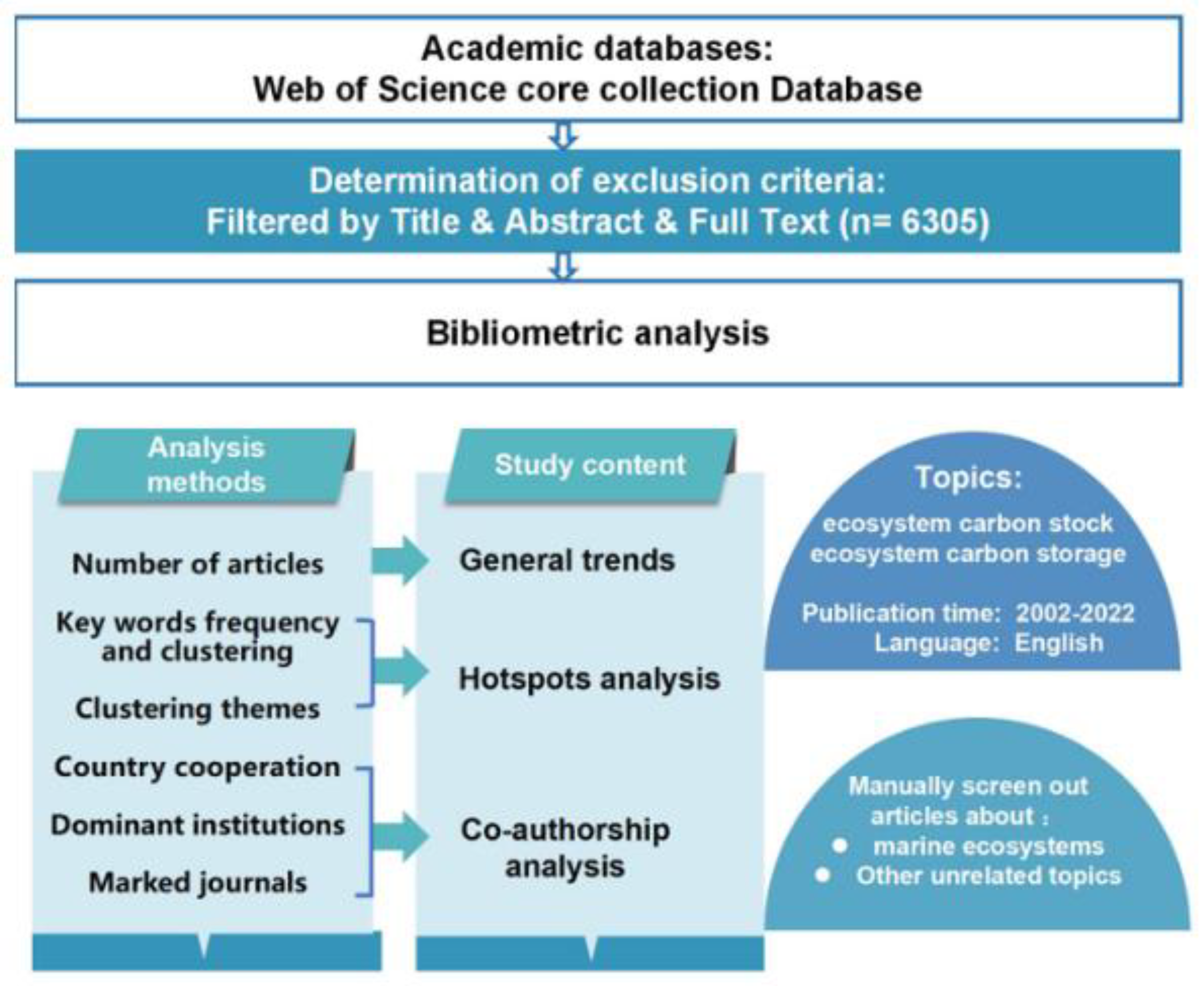
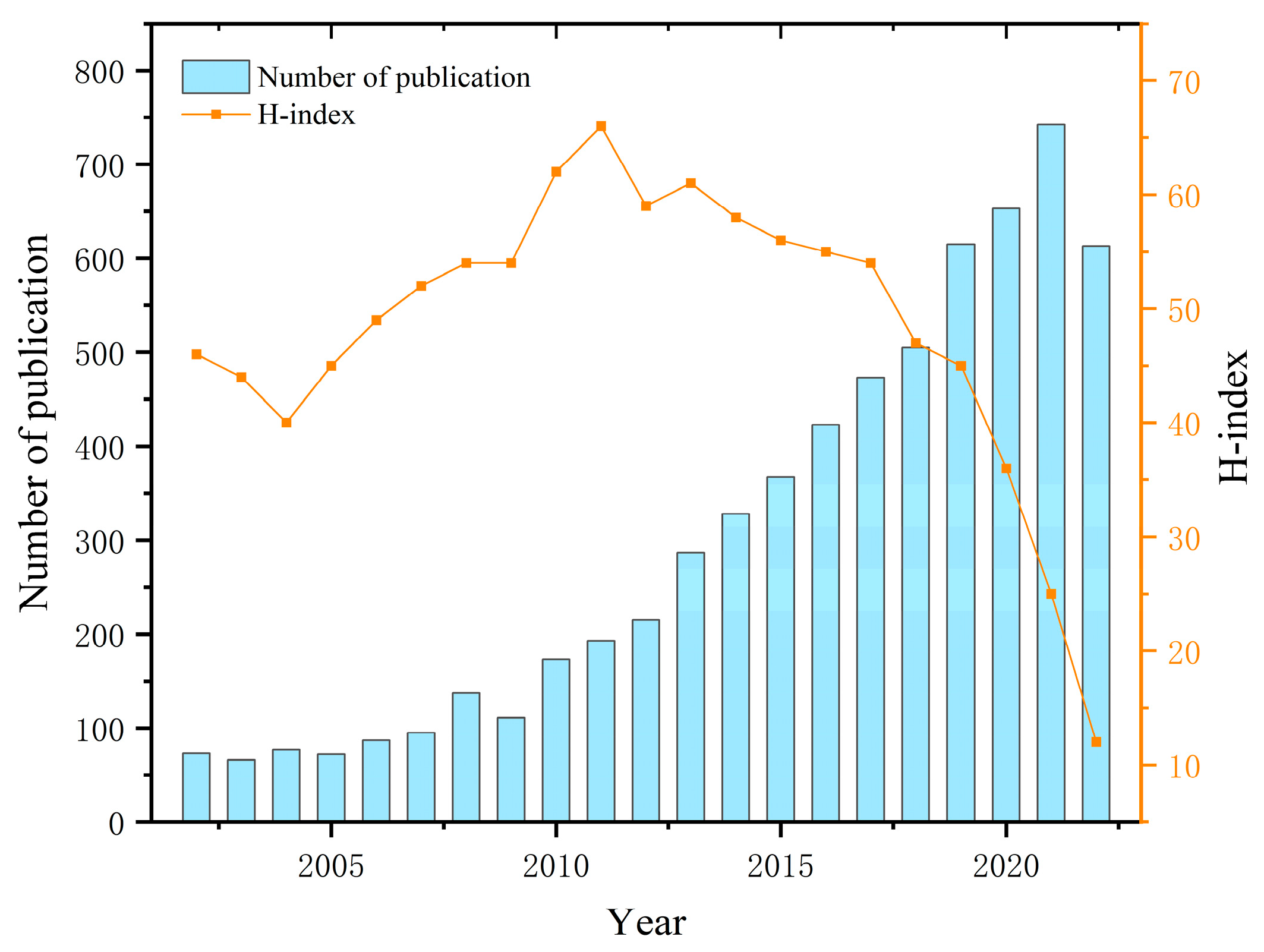

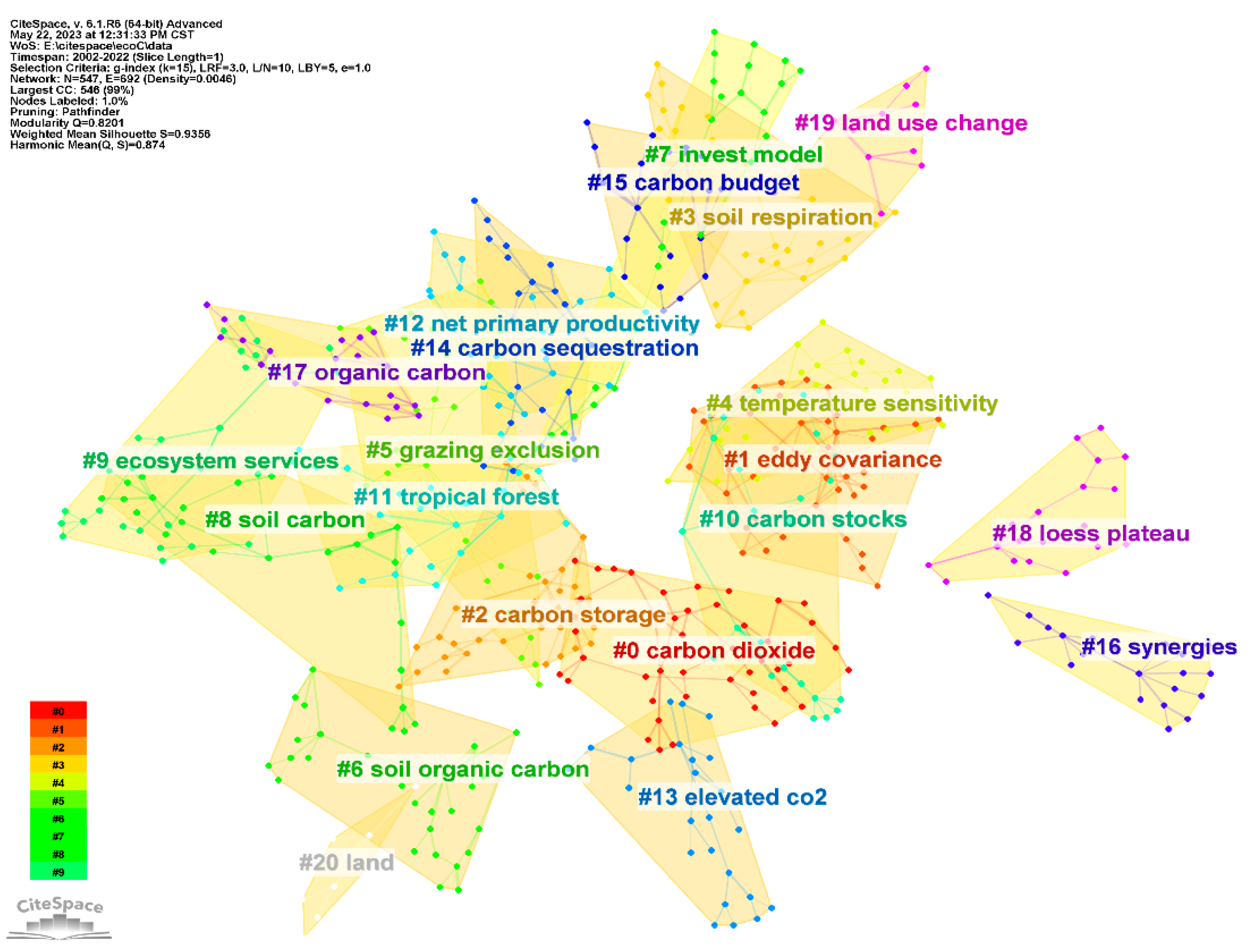
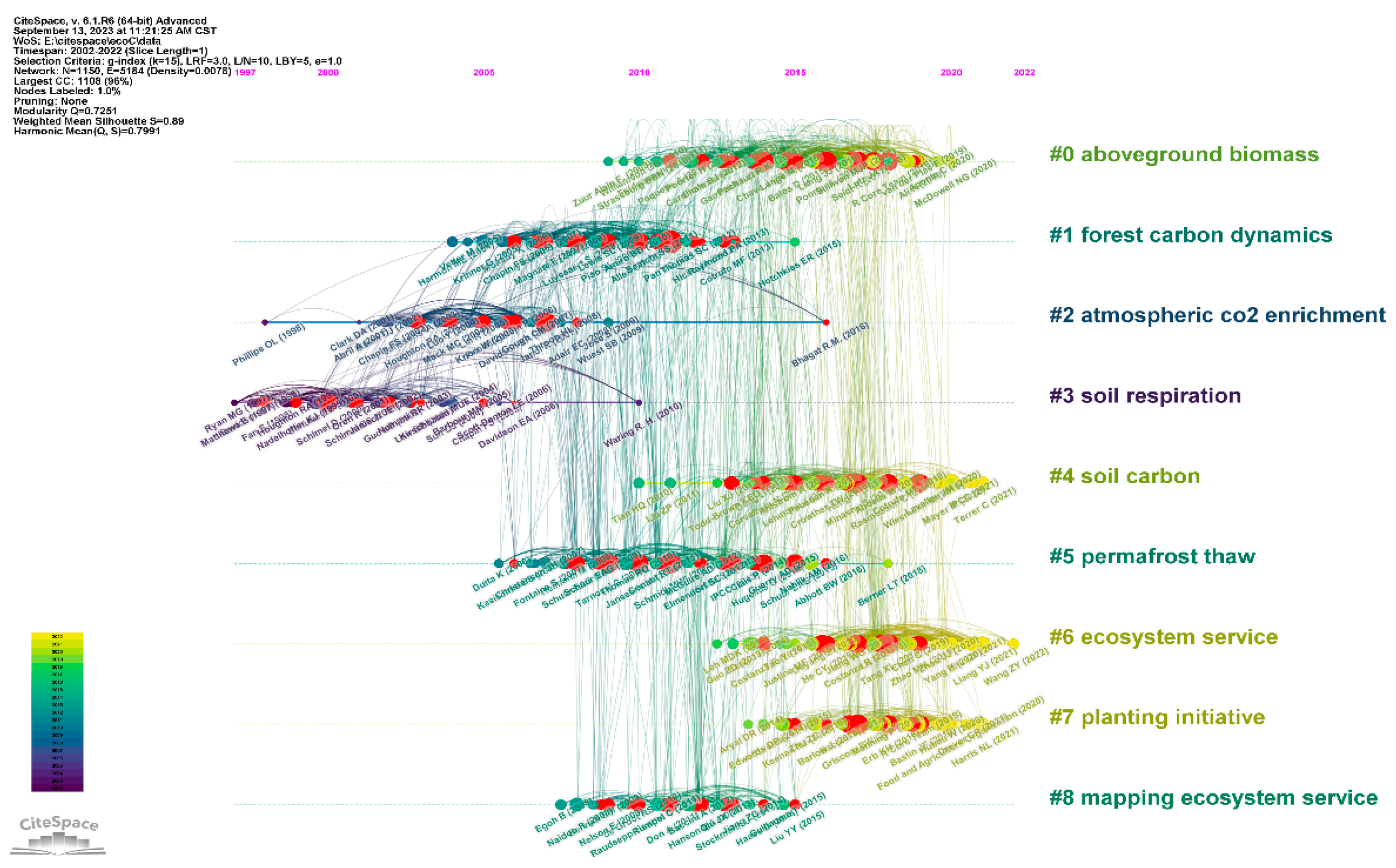
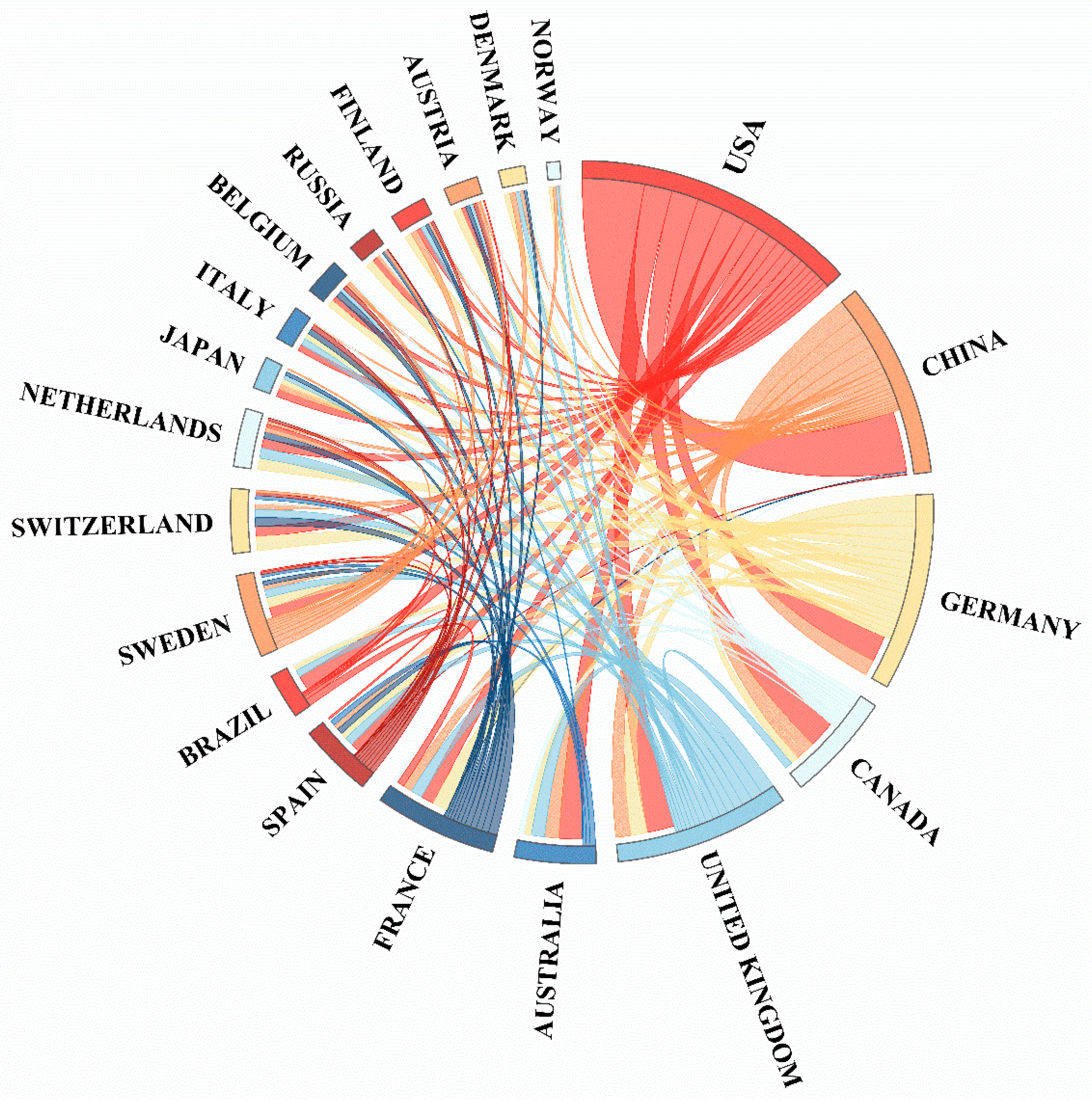

| Country | Publications | Centrality | H-Index |
|---|---|---|---|
| USA | 2129 | 0.08 | 141 |
| China | 1740 | 0.01 | 84 |
| Germany | 607 | 0.07 | 77 |
| Canada | 523 | 0.02 | 66 |
| United Kingdom | 432 | 0.12 | 75 |
| Australia | 384 | 0.10 | 59 |
| France | 305 | 0.09 | 62 |
| Spain | 273 | 0.08 | 47 |
| Brazil | 259 | 0.01 | 51 |
| Sweden | 254 | 0.10 | 54 |
| Journal | Country | Publications | Co-Citation Count | Impact Factor |
|---|---|---|---|---|
| Forest Ecology and Management | Netherlands | 490 | 16,877 | 3.7 |
| Forests | Switzerland | 252 | 2160 | 2.9 |
| Global Change Biology | United Kingdom | 249 | 24,744 | 11.6 |
| Agriculture Ecosystems Environment | Netherlands | 213 | 9733 | 6.6 |
| Journal of Geophysical Research Biogeosciences | USA | 204 | 5155 | 3.7 |
| Biogeosciences | Germany | 203 | 8432 | 4.9 |
| Science of the Total Environment | Netherlands | 191 | 4957 | 9.8 |
| Ecological Indicators | Netherlands | 184 | 4794 | 6.9 |
| Ecosystems | USA | 178 | 7818 | 3.7 |
| Environmental Research Letters | United Kingdom | 155 | 3250 | 6.7 |
| Author | Institution | Country | Publications | H-Index |
|---|---|---|---|---|
| Ciais, Philippe | Centre National de la Recherché Scientifique | France | 39 | 24 |
| Luo, Yiqi | Cornell University | USA | 36 | 18 |
| Kurz, Werner A | Canadian Forest Service | Canada | 27 | 19 |
| Law, Beverly Elizabeth | Oregon State University | USA | 26 | 25 |
| Tian, Hanqin | Nanjing University of Information Sci & Technology | China | 25 | 19 |
| Penuelas, Josep | Autonomous University of Barcelona | Spain | 25 | 15 |
| Woodall, Christopher W | United States Forest Service | USA | 25 | 12 |
| Piao, Shilong | Chinese Academy of Sciences | China | 24 | 16 |
| He, Nianpeng | Chinese Academy of Sciences | China | 24 | 15 |
| Kellomaki, Seppo | University of Eastern Finland | Finland | 24 | 15 |
Disclaimer/Publisher’s Note: The statements, opinions and data contained in all publications are solely those of the individual author(s) and contributor(s) and not of MDPI and/or the editor(s). MDPI and/or the editor(s) disclaim responsibility for any injury to people or property resulting from any ideas, methods, instructions or products referred to in the content. |
© 2023 by the authors. Licensee MDPI, Basel, Switzerland. This article is an open access article distributed under the terms and conditions of the Creative Commons Attribution (CC BY) license (https://creativecommons.org/licenses/by/4.0/).
Share and Cite
Sawirdin, S.; Tian, A.; Shi, L.; Fu, W.; Cheng, S.; Halik, Ü.; Liang, J. A Bibliometric Analysis of the Research Progress and Trends during 2002–2022 on the Carbon Stocks in Terrestrial Ecosystems. Forests 2023, 14, 2051. https://doi.org/10.3390/f14102051
Sawirdin S, Tian A, Shi L, Fu W, Cheng S, Halik Ü, Liang J. A Bibliometric Analysis of the Research Progress and Trends during 2002–2022 on the Carbon Stocks in Terrestrial Ecosystems. Forests. 2023; 14(10):2051. https://doi.org/10.3390/f14102051
Chicago/Turabian StyleSawirdin, Subinur, Aolei Tian, Lei Shi, Wentao Fu, Shengyuan Cheng, Ümüt Halik, and Jiye Liang. 2023. "A Bibliometric Analysis of the Research Progress and Trends during 2002–2022 on the Carbon Stocks in Terrestrial Ecosystems" Forests 14, no. 10: 2051. https://doi.org/10.3390/f14102051
APA StyleSawirdin, S., Tian, A., Shi, L., Fu, W., Cheng, S., Halik, Ü., & Liang, J. (2023). A Bibliometric Analysis of the Research Progress and Trends during 2002–2022 on the Carbon Stocks in Terrestrial Ecosystems. Forests, 14(10), 2051. https://doi.org/10.3390/f14102051








